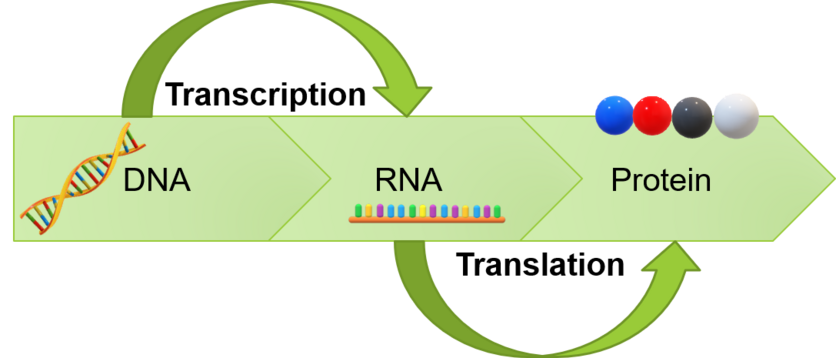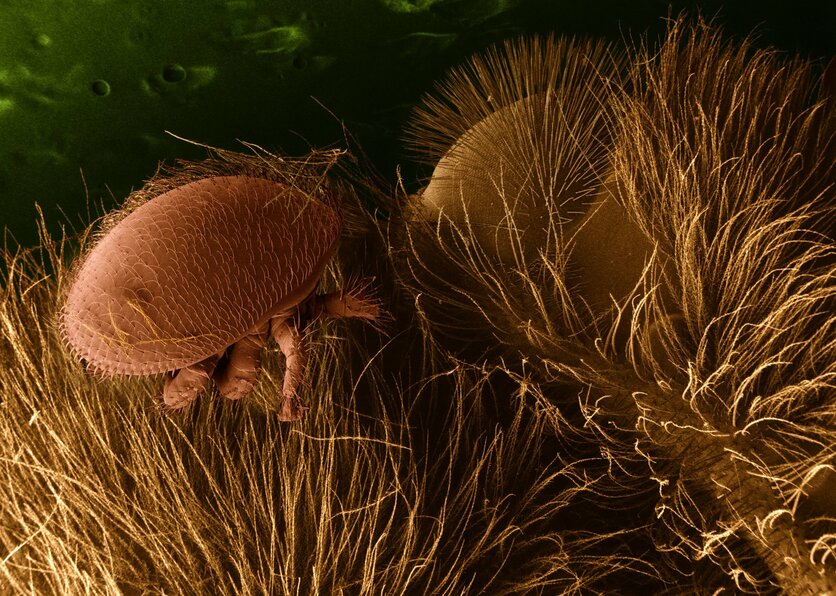RNA interference (RNAi) is a natural process that occurs in cells where small RNA molecules ‘silence’ or decrease the activity of specific genes by preventing them from making proteins.
DNA and RNA
DNA is like a genetic blueprint that contains instructions for an organism to live and survive. These instructions are called genes, and they are found in the nucleus of every cell. RNA is a molecule that helps carry out many different jobs in cells, one of which is gene expression. To use the instructions in DNA, the cell needs RNA to help read and copy them through transcription. This is done using a type of RNA called messenger RNA (mRNA), which carries the instructions outside of the nucleus to undergo translation at the ribosomes to make proteins. Proteins are essential for an organism to grow and function correctly because they act like building blocks.
The natural RNAi process
Sometimes, mistakes happen in an organism’s genetic instructions or a virus can enter an organism and affect its genes. RNA can help fix these mistakes or fight the viruses.
There are many types of RNA. Double-stranded RNA (dsRNA) is RNA with two complementary strands. There are also different types of dsRNA such as small interfering RNA (siRNA), which plays a crucial role in the RNAi process. Some viruses, like rotaviruses, are double-stranded.
Cells have evolved a mechanism to break down the harmful dsRNA and also stop the virus from multiplying using RNA interference (RNAi). RNAi is a process that occurs naturally and regularly in a wide variety of organisms such as fungi, plants, humans, animals such as ducks, and mites. It’s like a ‘stop button’ that cells can use to slow down or regulate the production of gene expression and therefore can prevent protein production too.
Modification of the natural process
RNA interference is also a biotechnology tool used for temporarily silencing a gene.
Step 1: A long piece of synthetic dsRNA is introduced to the cell, which is designed to be specifically matched up with a target mRNA molecule that encodes for a gene. This gene could be essential for ensuring the survival of a pest or could impact production of proteins responsible for development of a disease.
Step 2: When a cell identifies dsRNA, cellular structures are activated that cut up the dsRNA into smaller double-stranded pieces – siRNA.
Step 3: With help from the guide strand of the siRNA, other cellular structures attach to the smaller pieces of RNA, turning (unwinding) them into single-stranded RNA (ssRNA).
Step 4: The ssRNA pieces are matched and bind with mRNA. (This is where the dsRNA design becomes important in targeting specific mRNA.)
Step 5: Once the ssRNA matches with the mRNA, it prevents the mRNA from being translated into protein. The matching process stops gene expression from happening, as this normally occurs when mRNA carries the genetic information from DNA to ribosomes for translation into protein.
The difference between RNAi and gene editing
RNAi and gene editing are two different approaches used for gene silencing in biotechnological experiments. RNAi reduces the expression of a gene and therefore temporarily knocks down the expression of a gene by targeting its mRNA sequence. Gene editing technologies – like CRISPR/Cas9 – intend to permanently eliminate or knock out a gene by working at the DNA level to target its DNA sequence. Both approaches can be useful for different applications and experiments.
Medical applications
RNAi can be used in humans to target genes that produce faulty or excessive proteins that cause disease symptoms, potentially leading to the treatment of such conditions. RNAi is also being studied as a possible means to combat cancer by blocking the production of proteins in cancer cells.
New Zealand’s Biological Heritage National Science Challenge
The Novel Tools and Strategies – Invertebrates team, co-led by Dr Phil Lester, Dr Ocean Mercier and Symon Palmer, have proposed using RNA interference to manage pest populations, particularly the varroa mite in Aotearoa New Zealand, as part of the BioHeritage Challenge. The researchers aim to improve the national biosecurity network by implementing innovative tools and strategies to control invertebrate pests.
Related content
Researchers have created a spray that induces RNA interference to slow the spread of myrtle rust.
Researchers have also explored te ao Māori considerations of novel pest control tools – like RNAi.
Novel biotechnologies that involve genetic technologies are often socio-scientific issues. This context for learning curates Hub resources on RNAi and genetic engineering and provides pedagogical suggestions.
For explanations of concepts and relevant vocabulary, see RNA interference – key terms.
The following resources provide helpful background information:
- DNA, chromosomes and gene expression
- Proteins – what they are and how they’re made
- Cell biology and genetics
- The genotype/phenotype connection
- Identifying Mendel’s pea genes (gene expression)
The article Modern biotechnology has other examples of genetic modification.
Activity ideas
In RNAi – making science-informed responses, ākonga use a variety of resources to consider personal, societal and science perspectives and make a science-informed response to the use of RNAi as a means of pest control.
Useful links
Visit the New Zealand’s Biological Heritage – Ngā Koiora Tuku Iho website:
Visit the University of Massachusetts Chan Medical School RNA Therapeutics Institute site for videos and information about the use of RNAi in medicine.
The Ministry for the Environment booklet Genetic modification – the New Zealand approach, published in 2004, aims to answer some of the basic questions you might have about what genetic modification is, how applications to use it can be made and how they are controlled and managed in New Zealand.
Read the 2019 report Gene editing – legal and regulatory implications from the Royal Society Te Apārangi.
Acknowledgement
This article was written by Tere Porter-Rawiri (Te Ātiawa, Taranaki, Ngāti Mutunga).



